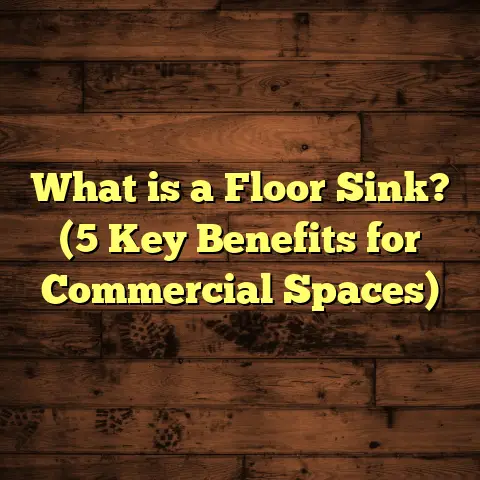What is Floor Tiling? (5 Essential Benefits You Must Know)
Waterproof flooring options have always grabbed my attention because of how
practical they are, especially in areas like kitchens, bathrooms, and laundry rooms.
When I first started working in the flooring business, I noticed how many clients
struggled with water damage, warping floors, and mold problems. That’s when floor
tiling really stood out to me—not only for its visual appeal but also for its ability
to resist water and wear over time. If you’ve ever wondered what floor tiling is and
why it might be a smart choice for your home or project, stick around. I’ll share
everything I’ve learned through hands-on experience, with some data and stories that
might just help you decide what’s best for your space.
What Is Floor Tiling?
Floor tiling is the process of covering a floor surface with tiles made from hard, durable
materials such as ceramic, porcelain, natural stone, or glass. These tiles are usually
square or rectangular but can come in all sorts of shapes and sizes. They’re installed
in patterns or grid layouts, bonded to the subfloor with adhesives or mortar, and sealed
with grout to fill the gaps—creating a smooth, sturdy surface.
When I first started learning about flooring, tiles fascinated me for their versatility.
You can find a tile to match virtually any style—from classic white subway tiles to bold
geometric designs or rustic stone slabs. The installation involves several technical steps:
preparing the subfloor for a flat surface, mixing and applying adhesive, laying each tile
carefully to maintain levelness and spacing, and finally sealing grout lines to prevent
moisture seeping through.
Materials Used in Floor Tiling
Tile materials vary widely and each type brings specific advantages and challenges:
- Ceramic Tiles: Made from fired clay with a glazed surface. They’re affordable and come in many colors and patterns but tend to be less dense than porcelain.
- Porcelain Tiles: A subtype of ceramic but fired at higher temperatures making them denser, harder, and less porous. They absorb less than 0.5% water, which means they’re great for wet areas.
- Natural Stone Tiles: Marble, granite, limestone, slate, travertine—these tiles offer unique natural patterns but usually require more maintenance and sealing.
- Glass Tiles: Often used decoratively or on walls but can be installed on floors in low-traffic areas.
- Cement Tiles: Handmade or machine-made with vibrant patterns; they need sealing to protect against stains.
From a technical perspective, tile thickness usually ranges from 6mm to 12mm or more. Thicker tiles can handle heavier loads but may require stronger subfloor support.
Installation Basics
I’ve installed hundreds of square feet of tile over the years. The process typically involves:
- Subfloor Preparation: Ensuring the surface is clean, level, and free of cracks. Any unevenness can cause tiles to crack or pop loose.
- Layout Planning: Deciding where to start tiling so you get symmetrical cuts on edges and no awkward small pieces.
- Applying Adhesive or Mortar: Using a notched trowel to spread evenly.
- Setting Tiles: Placing tiles carefully with spacers to maintain consistent grout lines.
- Cutting Tiles: Using a wet saw or tile cutter for edges and around obstacles.
- Grouting: Filling gaps between tiles with grout after adhesive cures.
- Sealing (if needed): Applying sealant over grout or stone tiles to protect from moisture and stains.
Why Floor Tiling Is More Than Just Looks
Beyond aesthetics, floor tiling offers practical benefits that few other flooring types can match. The water resistance alone makes it a go-to option for kitchens, bathrooms, mudrooms, entryways—anywhere moisture is a concern.
I remember early in my career working on a family bathroom where the previous floor was laminate that had swollen up because of leaks underneath. Replacing it with porcelain tiles solved their issue completely. Since then, I’ve been a strong advocate for tile wherever water exposure is likely.
5 Essential Benefits of Floor Tiling You Must Know
Let me walk you through five benefits that make floor tiling an excellent choice based on my experience and some data I gathered from industry sources.
1. Waterproof and Moisture Resistant
Waterproofing is probably the biggest selling point for tile floors. Unlike hardwood or laminate that warp and swell when exposed to water, tile floors stay solid and intact.
Porcelain tiles have water absorption rates below 0.5%, meaning they absorb almost no moisture at all. Ceramic tiles vary more but still offer good resistance compared to other materials.
Grout lines between tiles are potential weak spots for moisture seepage but applying quality grout sealers during installation creates an effective barrier against water penetration.
I worked on a large-scale renovation for a lakeside cabin where high humidity and occasional flooding were constant threats. The client chose thick porcelain tiles with epoxy grout and an additional waterproof membrane underneath. This system kept the structure dry despite heavy rains.
In residential construction data from the Tile Council of North America (TCNA), homes with tiled bathrooms report 70% fewer water-related flooring issues compared to laminate or hardwood floors in similar conditions.
2. Long-Term Cost Efficiency
Tile flooring costs more upfront than vinyl or laminate, but its lifespan is much longer—often 30 to 50 years or more if installed properly.
The National Tile Contractors Association states that ceramic and porcelain tile floors can last upwards of five decades without replacement under normal residential use. Compare that to hardwood floors that might need refinishing every 7-10 years or vinyl replaced every 10-15 years.
I once worked with a homeowner who initially balked at the price of tile installation but later thanked me after five years when their tile floors still looked brand new while their friends struggled with peeling vinyl.
Maintenance costs are also lower since tile is easy to clean and doesn’t require sanding or resealing like wood floors do regularly.
3. Design Flexibility and Style Variety
If you want creative freedom when choosing your floors, tile has you covered.
Tiles come in endless colors, sizes (from tiny mosaics to large slabs), shapes (hexagon, rectangle, diamond), finishes (matte, glossy, textured), and patterns (herringbone, basketweave).
I enjoy mixing different styles for clients—like pairing rustic slate tiles with modern glass mosaics around borders.
One kitchen remodel I did involved custom-cut porcelain tiles arranged in a chevron pattern that created a striking visual effect. It really personalized the space without sacrificing durability.
According to Houzz’s 2023 report on kitchen design trends, over 65% of homeowners prefer patterned or textured tile floors over plain surfaces because they add character and hide dirt better.
4. Easy Maintenance and Hygiene
Tiles don’t harbor dust mites, pet dander, or allergens like carpets do—making them a healthier choice for allergy sufferers.
Regular cleaning involves sweeping dirt away and damp mopping with mild soap. Stubborn grout stains are manageable with baking soda paste or specialized grout cleaners.
I’ve had clients with children prone to spills who appreciate how quickly messes wipe up on tiled surfaces compared to sticky carpets or vulnerable hardwoods.
In commercial environments like hospitals and restaurants where hygiene is critical, tile is often the flooring material of choice because it withstands frequent cleaning with disinfectants without damage.
5. Heat-Friendly and Energy Efficient
If you’re considering radiant floor heating, tile is one of the best options because it conducts heat efficiently and retains warmth longer than carpet or wood.
I installed heated floors beneath tiles in mountain cabins where winters are harsh. The owners reported lower heating bills and much more comfortable living spaces.
Tiles reflect sunlight well too; in hot climates this helps keep floors cooler during summer months compared to dark wood or vinyl surfaces that absorb heat.
Data from the U.S. Department of Energy confirms that radiant heating combined with tile flooring can reduce heating energy consumption by up to 15% compared to forced-air systems paired with other floor types.
How I Use Tools Like FloorTally for Cost Estimation
Managing budget expectations is a big part of my job as a flooring contractor.
Estimating what floor tiling will cost isn’t as simple as multiplying square footage by price per tile—there are so many other factors: tile type and grade, labor rates in your area, waste factor (cutting tiles generates scrap), sealers, grout types…
That’s why I often turn to tools like FloorTally for quick yet detailed cost estimates. It lets me enter local labor costs alongside specific materials chosen by the client. It even factors in waste percentage automatically based on tile size and room layout complexity.
This tool saves me hours compared to chasing quotes from suppliers manually or guessing percentages on waste which might lead to ordering too many or too few tiles.
For instance, on a recent kitchen project:
- Room size: 250 sq ft
- Porcelain tiles at $8/sq ft
- Labor rate: $4/sq ft
- Waste factor: 12%
FloorTally provided an estimate including materials, labor, grout costs, and waste allowance totaling about $3,200—which matched my real-world bids closely.
Having this clear cost breakdown helped my client understand where their money was going and avoid surprises later during installation.
A Deeper Look Into Installation Challenges
While floor tiling offers many benefits, it’s not without challenges if you don’t know what you’re doing—or if shortcuts are taken.
Subfloor Issues
One mistake I see frequently is skipping proper subfloor preparation. Even slight unevenness can cause tiles to crack or loosen over time.
I recall one job where the subfloor wasn’t leveled properly before ceramic tile installation. Within months small cracks appeared in multiple spots requiring expensive repairs.
A good subfloor should be flat within 1/8 inch over 10 feet. If not level enough, self-leveling compounds might be needed before tiling begins.
Grout Problems
Grout quality varies widely between products; cheap grout tends to shrink or crack causing gaps where water can penetrate beneath tiles leading to mold growth.
Epoxy grout is more durable but costs more upfront. Regular grout sealing after installation extends longevity by preventing stains and moisture absorption.
On one project using natural stone tiles prone to staining, we resealed grout annually which kept everything looking pristine after several years.
Tile Size & Layout Considerations
Large-format tiles (like 24×24 inches) create fewer grout lines but require very flat subfloors due to their rigidity—otherwise they can crack easily under pressure points.
Small mosaic tiles offer flexibility on curved surfaces but take longer to install which increases labor costs.
Choosing the right size depends on room dimensions and traffic expectations—a balance between aesthetics, ease of installation, and durability.
Sharing Some Personal Stories From My Work
Beyond technical details, some personal experiences have shaped how I approach floor tiling:
- A client whose toddler loved spilling juice was relieved when we installed glazed ceramic tiles that wiped clean easily—her peace of mind was priceless.
- For an elderly couple aiming for slip resistance in their bathroom renovation, we used textured porcelain matte finish combined with anti-slip grout additives.
- Another memorable job involved restoring a historic home’s original terrazzo tile floors rather than replacing them—finding craftsmen skilled enough was a challenge but worth it for preservation.
- I once dealt with flooring in a commercial kitchen where hygiene standards were strict; we selected large porcelain tiles with epoxy grout resistant to harsh cleaning chemicals.
- In a coastal home renovation project prone to salty air corrosion issues, we recommended porcelain over natural stone because it resists salt damage better long-term.
My Recommendations When Considering Floor Tiling
If you’re thinking about tiling your floors soon here are some tips based on what I’ve seen work best:
- Choose materials suited for your environment: Porcelain for wet areas; natural stone for dry living spaces; glass sparingly.
- Don’t skimp on installation quality: Hire experienced professionals if possible.
- Prepare your budget realistically: Factor in extras like underlayment membranes or radiant heating compatibility.
- Think about future maintenance: Seal grout lines regularly; clean appropriately.
- Pick tile sizes & patterns that complement room scale: Large rooms suit bigger tiles; small rooms benefit from mosaics or patterned layouts.
- Use digital tools for cost planning: It helps avoid surprises mid-project and keeps finances transparent.
- Consider eco-friendly options: Some manufacturers produce low-VOC adhesive & grout products reducing indoor air pollution.
- Ask about warranties: Good installers offer guarantees on workmanship; quality materials often come with manufacturer warranties too.
Wrapping Up My Thoughts on Floor Tiling
Floor tiling is more than just putting down pretty squares on your floor; it’s about choosing a surface that holds up against life’s messes while adding style
and value to your home.
Over the years installing hundreds of projects—and sometimes correcting others’ mistakes—I’ve learned that good tile work combines technical precision with design sense plus understanding your lifestyle needs.
If waterproofing tops your list or you want floors that last decades without fuss—tile checks those boxes like few other options do.
Have questions about which tile fits your budget? Wondering how much labor will cost? Need design ideas? Just ask—I’m happy to share what tools like FloorTally have taught me about making flooring projects smoother from estimate through completion.
Remember: Your floor isn’t just a surface—it’s the foundation of your home’s comfort and style for years ahead.
If you want me to break down any step in more detail or share specific case studies from my projects
with photos and cost breakdowns just let me know!





